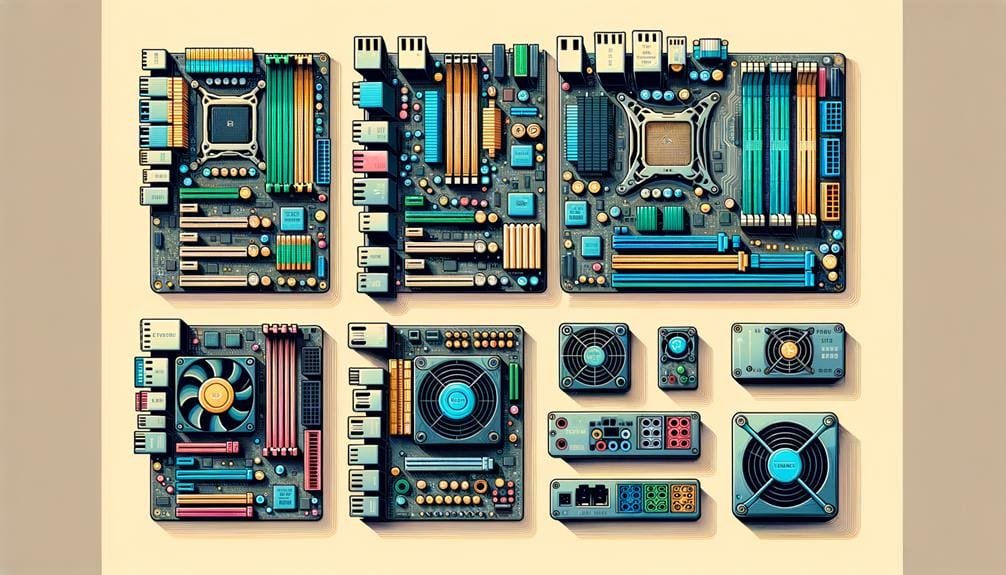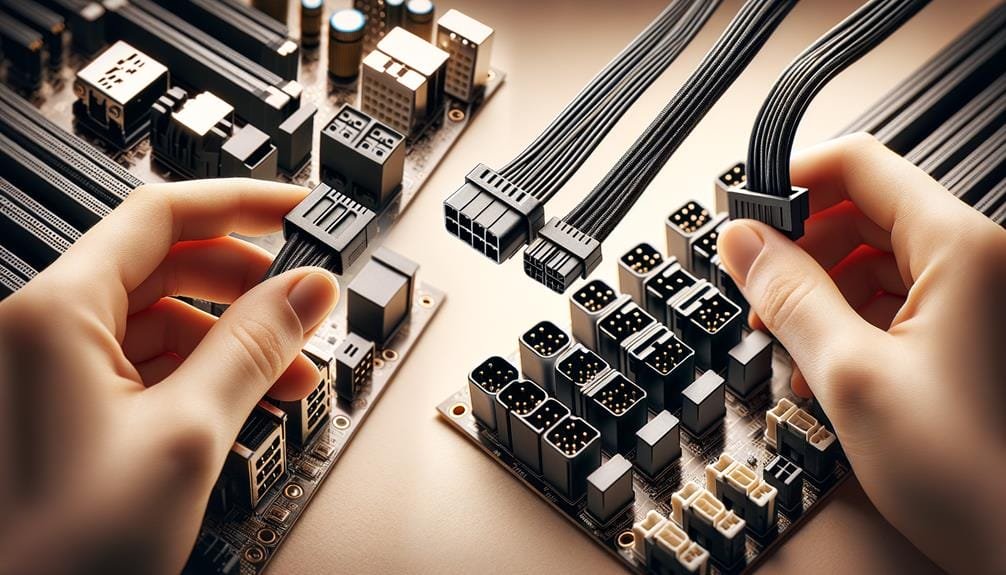Our Newsletter
Sign up for our e-mail newsletter and stay informed for what’s next on the horizon.
Imagine you’re a skilled orchestra conductor, fine-tuning the harmony between every instrument. In this scenario, your computer is the orchestra, with the power supply unit (PSU) and motherboard as crucial players.
Striking the right chord between these can seem like a daunting task, but don’t fret. This guide will offer you nine comprehensive tips to ensure your PSU is perfectly in sync with your motherboard.
From checking the form factor to understanding the PSU’s efficiency rating, you’ll navigate through the process smoothly.
By following these tips, you’ll not only guarantee a perfect performance but also protect your hardware from potential damage.
So, gear up to master the subtle art of PSU compatibility with your motherboard.

When considering PSU compatibility, the form factor of your motherboard is a cornerstone. This aspect determines the physical compatibility and power requirements of your setup.
ATX Motherboards: These are widely used due to their size and flexibility. An ATX motherboard typically requires a standard ATX PSU. However, while this seems straightforward, it’s essential to consider future upgrades. Suppose you plan to add more components like additional GPUs or hard drives; in this case, a PSU with higher wattage might be a wiser choice, even if it’s currently more than you need.
Micro-ATX and Mini-ITX: For those who prefer a more compact, space-saving setup, these smaller form factors are ideal. However, selecting a PSU for these might be trickier. You need a unit that not only fits into smaller cases but also provides sufficient power. This might lead you to think that smaller PSUs are less powerful, but that’s not always the case. Advances in PSU technology have made it possible to find small yet powerful units, suitable for high-performance components in compact builds.
Another aspect that’s often overlooked in the quest for PSU compatibility is the power connector. Most motherboards use a 24-pin main power connector, but there are variations, especially in older or specialized models. For instance, some server motherboards might require different connectors.
Here’s a practical example: Imagine you’re refurbishing an old PC. You find that its motherboard has a 20-pin connector, while modern PSUs predominantly offer 24-pin connectors. Fortunately, many of these are designed to be backward compatible, allowing you to use them with older motherboards by leaving out the extra pins. However, this isn’t a universal feature, and assuming compatibility without checking could lead to an unsuccessful build.

When assembling or upgrading a PC, the compatibility between your power supply unit (PSU) and motherboard is a cornerstone for system stability and efficiency. Choosing the right PSU is more than just matching wattage numbers; it’s about ensuring that your system’s heart (the motherboard) gets the power it needs in the most effective manner.
To guarantee PSU compatibility with your motherboard, start by listing all your PC components: CPU, GPU, RAM, drives, fans, peripherals, etc. Then, delve into the power consumption for each. You might find that the manufacturer’s specifications offer a good starting point. However, remember that these figures can vary based on the usage scenarios.
For example, a high-end GPU like the NVIDIA RTX 3080 may have a peak power consumption significantly higher under load than in idle state. This fluctuation needs to be accounted for in your PSU choice.
Let’s take a hypothetical gaming PC build:
Adding these up, we reach an estimated power requirement of around 457W. However, it’s wise to add a buffer (around 20-30%) to this figure for peak loads and future upgrades, pushing our requirement to approximately 600W.
It’s not just about wattage. PSU compatibility also hinges on the connectors. Most modern motherboards require a 24-pin ATX connector, but what about additional CPU power connectors? Some high-end boards need an 8-pin, or even a 4+4 pin connector. Ensure your PSU has these.
Efficiency ratings like 80 Plus Bronze, Silver, Gold, etc., play a role in PSU compatibility. Not directly with the motherboard, but in the overall energy efficiency of your system. A more efficient PSU can lead to lower electricity bills and less heat output.
For a system with high-end components, a PSU with stable rails (voltage lines) is crucial. Fluctuating voltages can harm components and lead to system instability.
| Component | Consideration | Example | Notes |
|---|---|---|---|
| CPU | Power Consumption | Intel Core i9 (95W TDP) | Check TDP and add buffer |
| GPU | Peak Power Usage | NVIDIA RTX 3080 (320W) | Consider load vs. idle power |
| Motherboard | Connector Type | 24-pin ATX, 8-pin CPU | Ensure PSU has required connectors |
| PSU Type | Modular vs Non-Modular | Modular for flexibility | Affects cable management |
| Efficiency | 80 Plus Rating | Gold Rated PSU | Impacts energy bills and heat output |
| Rails | Voltage Stability | Single Rail with High Amperage | Important for high-end components |

PSU compatibility is a critical aspect of building or upgrading a PC. It’s not just about the power supply fitting physically in your case; it’s about ensuring that it can effectively power your motherboard and other components. This compatibility impacts everything from system stability to future upgrade potential.
First and foremost in ensuring PSU compatibility is matching the PSU with the motherboard form factor. This step is crucial for both functional and physical compatibility. For instance, an ATX motherboard requires an ATX PSU. However, you might be surprised to find that some smaller form factors, like microATX, can also be compatible with standard ATX PSUs.
The physical dimensions of your case play a pivotal role in PSU compatibility. A common mistake is overlooking the case size when selecting a PSU. For example, a large ATX PSU might not fit in a compact Mini-ITX case, leading to unnecessary hassle and potential returns.
Imagine you’re building a small form factor PC using a Mini-ITX motherboard. You’ve selected a compact case designed for space efficiency. Here, PSU compatibility isn’t just about wattage or connectors; it’s about the physical size of the PSU. You’d need to opt for an SFX power supply, designed specifically for smaller cases.
The compatibility of power connectors is another layer to consider. Your motherboard’s requirement for an ATX power connector and a CPU power connector must align with what the PSU offers. For instance, some high-performance motherboards require additional CPU power connectors, which not all PSUs provide.
While assessing PSU compatibility, think about potential upgrades. Choosing a power supply with a higher wattage than currently necessary can offer more headroom for future component upgrades. However, this comes with a caveat. Overestimating your power needs can lead to unnecessary expenditure and less efficient power usage.
Another aspect to ponder is the aesthetic compatibility of the PSU with your case. A non-modular PSU in a case with a transparent side panel might not offer the clean, uncluttered look many builders seek. In contrast, a fully modular PSU can significantly enhance the visual appeal of your build.
Understanding the efficiency rating of a PSU is crucial in maximizing power usage and minimizing heat generation. This rating, denoted by the 80 PLUS certification, reflects how effectively the PSU converts AC power to DC power.
A higher efficiency rating means less wasted power, leading to lower electricity bills and a reduced environmental footprint.
You should also consider the efficiency rating of the PSU, as it greatly impacts both the performance of your system and your electricity bills. The efficiency rating is crucial when choosing between power supplies, especially for a new PSU.
In assessing the impact of the efficiency rating on performance, it’s crucial to remember that a higher-rated PSU not only reduces energy consumption but also enhances system stability. This is particularly important when considering PSU compatibility with motherboards.
The table below illustrates how different types of PSUs, specifically ATX and SFX, with varying efficiency ratings affect performance:
| PSU Type | Efficiency Impact on Performance |
|---|---|
| ATX | Higher efficiency ATX PSUs can deliver more stable power, meeting diverse power requirements and ensuring system stability. |
| SFX | Despite their compact size, efficient SFX PSUs provide reliable power via the appropriate connector pin, contributing to system performance. |
When choosing a PSU, consider a unit with a higher efficiency rating. This will not only improve the performance of your system but also ensure greater freedom and flexibility in your computing experience.

When you’re scrutinizing model-specific compatibility issues, understanding individual power requirements for different motherboard models is crucial.
It’s not just about matching the form factor or checking the number of connectors; the wattage requirements can drastically differ between models.
Understanding your motherboard’s specific power requirements is crucial to ensuring PSU compatibility and avoiding potential hardware issues. When considering a new power supply, make sure it provides enough power for your motherboard’s needs.
Here are some steps to follow:
Don’t underestimate the importance of selecting a high-quality PSU for your computer system. This isn’t just about PSU compatibility with motherboards, it’s also about protecting your investment in computer components like graphics cards and hard drives.
A quality PSU selection ensures that your PC case is getting the right power at the correct voltage. This is crucial for maintaining optimal performance and stability. Power fluctuations can cause serious damage to your components and lead to system failures.
A high-quality PSU also has protective circuitry to shield against overvoltage, reducing the risk of malfunctions or short circuits that could harm your hardware. It’s worth paying a bit more for this peace of mind. After all, it’s cheaper to invest in a good PSU now than to replace damaged components later.
Don’t forget about power protection measures like surge protectors and UPS. These can safeguard against power spikes, surges, and blackouts. With a quality PSU, you’re not just choosing a component that works with your motherboard. You’re choosing one that protects your entire system and ensures it operates at peak performance. That’s the true value of quality PSU selection.
So, you’ve done your homework and ensured your PSU is compatible with your motherboard. You’ve checked form factors, connectors, and wattage, and even scrutinized efficiency ratings. Remember John, who fried his entire system because he overlooked PSU compatibility? Well, that won’t be you.
Now, you’re not just protecting your hardware; you’re optimizing performance. You’ve taken a crucial step towards a smoother, more efficient computing experience. Well done!
Commence by scrutinizing the voltage ratings and power capacity of your Power Supply Unit (PSU), a vital component of your computer’s ecosystem. It’s essential that your PSU can furnish sufficient juice to your motherboard, the central hub of your PC’s operations. Fall short on this, and you’re courting disaster.
Moving on, harmonize the connectors. An ill-fitted connector spells incompatibility. Probe into the PSU’s form factor subsequently, an aspect that needs to resonate with your computer case and motherboard, forming a cohesive unit.
You have the liberty to select any PSU, provided it aligns with these criteria. The choices are as vast as the ocean, each providing a unique combination of power and compatibility. Whether you’re building a high-end gaming rig or a modest office PC, the right PSU will ensure that your computer runs smoothly and efficiently.
A common question we encounter is, ‘Does my power supply unit (PSU) compatible with my motherboard?’ To ascertain this compatibility, we first scrutinize the interplay between the PSU and the motherboard. Our process involves comprehending the diverse array of PSU connectors and their respective locations on the motherboard – a critical facet of the motherboard’s architecture.
The role of PSU wattage is pivotal; it needs to align with the power demands of the motherboard – an essential component of the computer’s core system. Additionally, we examine the PSU form factors, validating their precise fit within the computer case – a holistic part of the system.
The simple response is no, yet it’s crucial to understand potential implications.
An excessively potent PSU, while not harmful to your motherboard – the nerve center of your computer system – can inadvertently lead to unnecessary power expenditure and diminished energy competence.
This superfluous power allocation doesn’t pose a direct threat, but it’s neither the most economical nor the greenest solution.
For optimal functioning and prolonged system life, it’s advisable to harmonize your PSU with your system’s energy demands.
Initially, delve into the motherboard’s technical specifications to discern power source stipulations. Compatibility assessments encompass confirming that the Power Supply Unit’s (PSU) form factor resonates with your motherboard’s layout, be it ATX, Micro-ATX, or Mini-ITX. Additionally, ensure the PSU’s energy output level is congruent with, or surpasses, the motherboard’s energy consumption requirements.
Further compatibility confirmation necessitates that the PSU possesses the right connectors, accommodates your computer case, and aligns with the motherboard’s instruction manual or the manufacturer’s guidelines. In essence, these considerations form the core of validating compatibility between your motherboard and power supply, thereby ensuring a seamless integration of components within your computer’s architectural framework.
Sign up for our e-mail newsletter and stay informed for what’s next on the horizon.